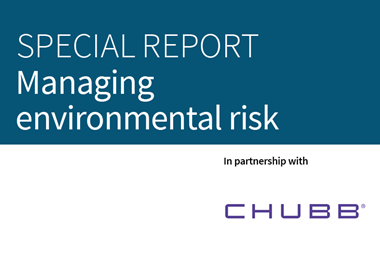No organisation – whatever their size or sector – is immune to increased environmental scrutiny
Part of an environmental risk series supported by
ACE environmental liability manager for Italy Deborah Sola is in no doubt. “Some companies still feel that environmental risk mainly affects bigger corporates or sectors that ‘traditionally’ pollute. This is certainly not true.
“With heightened media and public opinion interest and scrutiny, dealing with environmental risk should be a priority for companies of all sizes.”
Accepting this is one thing. But dealing with it is another. In Europe, there can be multiple overlapping national and pan-European regulations, while in the US, federal as well as state rules apply.
“In Italy the landscape has become very complex,” says Sola. “There is first-party and third-party liability and also now, in the case of an incident that damages the environment, companies not only have to compensate those affected, but also restore the natural habitat.
“There is even a D&O aspect to environmental risk, as executives can now be held personally accountable. And public authorities now have the right to act in advance against a company to prevent an incident from occurring.”
All this means there are additional responsibilities for companies. Every incident now has to be reported – whether it has caused damage to a third party or not. Even with minor incidents, companies have to follow the orders of the authorities. “Failure to comply may result in mitigation actions having to be repeated,” says Sola.
She acknowledges the implications of this. “Even if a major environmental disaster has not happened, a small incident can place a serious burden on a company,” she says.
If the organisation in question is a listed company, a £200,000 claim may be relatively insignificant. But for a family firm, it could lead to bankruptcy. There are already cases where this is happening and many medium-sized firms do not have the risk management or the insurance in place to address their exposure.
“The main trend is that [the situation] is getting more and more stringent, more complex,” says Dorothée Prunier, environmental risk manager Continental Europe at ACE. “Do not underestimate it and make sure you get local advice. You need to treat each country separately and get the best advice available. You cannot rely on generalisations.”
Prunier adds: “You need to think not only about the regulations, but also about how they are being applied.”
Case studies
SMALL OPERATORS, BIG IMPACT
Small firms in sectors not usually associated with environmental damage can have a huge exposure to risk, as these recent examples from the Italian food industry illustrate. ACE environmental liability manager Deborah Sola describes three incidents.
When a 60,000-litre milk tanker collapsed near a famous seaside tourist resort, the cost of the damage exceeded €350,000. The spill was not contained, entered the sewage system and ended up in the sea, causing damage to sea life and claims from hotels and tourists.
The leak of 30 cubic metres of ammonia into a river at a dairy products processing firm caused a loss of about €250,000. Four days after the leak, the river pollution stretched 20km downstream and resulted in tonnes of dead fish and serious environmental damage.
The malfunction of a treatment plant at a pig farm caused extensive damage to farmers. Untreated waste water from the sewage has a high nitrate concentration and, if used to irrigate the fields, can cause substantial damage. The company paid €350,000 in compensation.
CHANGE OF FOCUS
A more developed understanding of the impact of humans on the natural world is leading legislators to more closely monitor sectors that previously would not have been associated with pollution. In the US and across the EU, for example, authorities are scrutinising the procedures and operations of pharmaceutical firms.
“Even small irregularities in either finished products or manufacturing processes may have implications for companies, which may lead to the disposal of entire production batches,” says Grant Cropper, environmental compliance specialist at crisis management company Red24assist.
If a firm fails to adapt to increasingly cross-functional environmental regulatory compliance, risk management and operational excellence, this will have the knock-on effect of decreasing consent, product recalls and tremendous waste, says Cropper.
THINK ABOUT
1. Potential sources of an environmental crisis
Is there a contamination risk on or near your business? Or within your supply chain?
2. The pathway
How could this reach stakeholders or the wider environment, either directly or through your products?
3. The impact
If this happened, would it result in damage, injury, or require a regulatory enforced clean-up?
If this is the case, your firm could face large fines as well as potential social and reputational damage – unless appropriate insurance is in place.
Downloads
sr ace environment final
PDF, Size 22.07 mb




















No comments yet